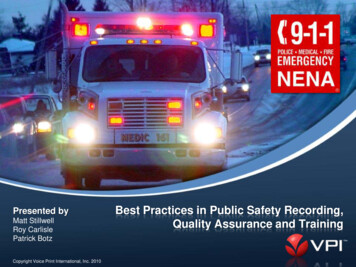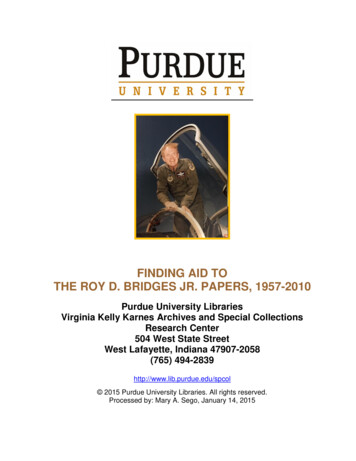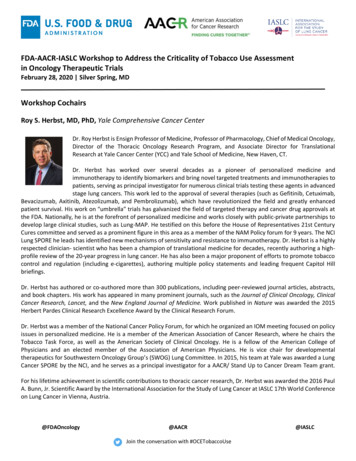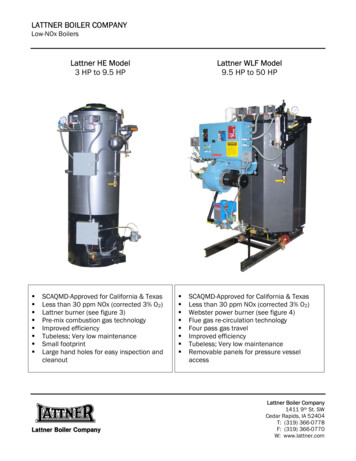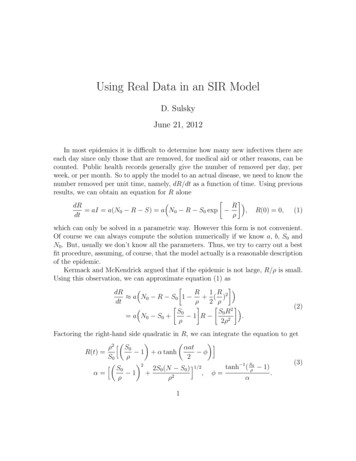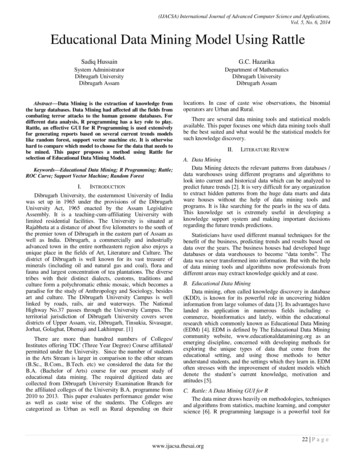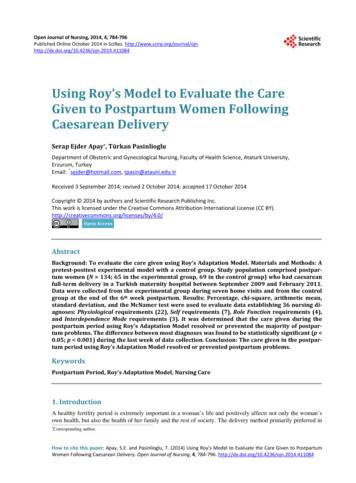
Transcription
Open Journal of Nursing, 2014, 4, 784-796Published Online October 2014 in SciRes. 10.4236/ojn.2014.411084Using Roy’s Model to Evaluate the CareGiven to Postpartum Women FollowingCaesarean DeliverySerap Ejder Apay*, Türkan PasinliogluDepartment of Obstetric and Gynecological Nursing, Faculty of Health Science, Ataturk University,Erzurum, TurkeyEmail: *sejder@hotmail.com, tpasin@atauni.edu.trReceived 3 September 2014; revised 2 October 2014; accepted 17 October 2014Copyright 2014 by authors and Scientific Research Publishing Inc.This work is licensed under the Creative Commons Attribution International License (CC tractBackground: To evaluate the care given using Roy’s Adaptation Model. Materials and Methods: Apretest-posttest experimental model with a control group. Study population comprised postpartum women (N 134; 65 in the experimental group, 69 in the control group) who had caesareanfull-term delivery in a Turkish maternity hospital between September 2009 and February 2011.Data were collected from the experimental group during seven home visits and from the controlgroup at the end of the 6th week postpartum. Results: Percentage, chi-square, arithmetic mean,standard deviation, and the McNamer test were used to evaluate data establishing 36 nursing diagnoses: Physiological requirements (22), Self requirements (7), Role Function requirements (4),and Interdependence Mode requirements (3). It was determined that the care given during thepostpartum period using Roy’s Adaptation Model resolved or prevented the majority of postpartum problems. The difference between most diagnoses was found to be statistically significant (p 0.05; p 0.001) during the last week of data collection. Conclusion: The care given in the postpartum period using Roy’s Adaptation Model resolved or prevented postpartum problems.KeywordsPostpartum Period, Roy’s Adaptation Model, Nursing Care1. IntroductionA healthy fertility period is extremely important in a woman’s life and positively affects not only the woman’sown health, but also the health of her family and the rest of society. The delivery method primarily preferred in*Corresponding author.How to cite this paper: Apay, S.E. and Pasinlioglu, T. (2014) Using Roy’s Model to Evaluate the Care Given to PostpartumWomen Following Caesarean Delivery. Open Journal of Nursing, 4, 784-796. http://dx.doi.org/10.4236/ojn.2014.411084
S. E. Apay, T. Pasinliogluterms of maternal and infant health is vaginal delivery [1]. However, when vaginal delivery is considered to bedangerous for the mother and/or the foetus, a caesarean operation becomes obligatory [2]-[4]. There have alsobeen more recent social reasons contributing to a significant increase in the caesarean delivery rate [5].In the majority of developed countries, 15% - 25% of births are caesarean deliveries [2]. By contrast, a significant increase in the caesarean delivery rate in Turkey has been reported, indicating that caesarean deliveryrate increased from 6.9% in 1993 to 14.0% in 1998, 21.2% in 2003 and 36.7% in 2008 [6].Caesarean delivery is an operation that carries risks for both the mother and the foetus. In caesarean deliveriesthe maternal mortality rate is higher, medical intervention is greater and the duration of hospital stay and thehealing period are longer. Later mobilisation, higher rate of risks for development of infection, delay in motherbaby interactivity and lactation, a longer period of transition to oral feeding and having a surgical procedure areall unwanted effects of caesarean section. These effects might increase the mother’s anxiety and fear, and negatively affect her health [7] [8].The postpartum period is a critical period in terms of maternal health. It is a difficult period when the motherhas to undertake new roles and responsibilities in addition to adapting to her physiological changes [7]. The firstweek of the postpartum period, especially the first 24 hours, is a physiological and psychological transition period when postpartum complications are at their highest level. Studies have concluded that mothers indulge in“navel-gazing” for at least 24 hours due to the physiological and psychological changes they are experiencing,and that their motivation levels to learn are at their lowest [9]-[11]. As understood from these studies, it is vitalto also continue the care given at the hospital to a woman giving birth at home. Therefore, in the literature reports have emphasized that when nurses or midwives follow-up the care of postpartum women at home duringthis postpartum period there are beneficial results [11]-[16].The majority of the problems encountered during the postpartum period can be prevented or reduced by effective nursing/midwifery care and training. Seemingly simple problems can be recovered by timely interventionbefore they become complicated, such complications can affect both the mother and child’s life for many years.Various studies have shown that during the postpartum period mothers and infants who are monitored and caredfor at home after early discharge have lower rates of returning to hospital and hospitalization due to health problems [12] [15] [17]-[19]. Extensive, standardised and qualified nursing care and training given to the motherduring the postpartum period enables conscious self-care, competency in motherhood and care and developmentof herself and her infant, as well as positive health behaviours and health status.Midwives and nurses are the closest people to the mother during the postpartum period. It is therefore important for them to consider the social and psychological requirements of the family, as well as that of the motherand the newborn in the postpartum period. In order for these requirements to be understood, the mother shouldbe closely followed during the postpartum period.Roy explains behavioral responses in four adaptive modes. These are the physiological, the self-concept, therole function and the interdependence adaptive modes. The physiological mode is related to the physical responses displayed by a person towards the stimulants arising from their environment. The self-concept mode isthe combination of an individual’s beliefs and feelings about themselves in a specific period. Within the rolefunction mode, Roy defines the concept of role as when “a person displays the behaviours expected by societydue to his/her position in society, in order to maintain his/her position (mother, student, etc.)” or “a personknows how to act when he/she passes from one position to another”. The interdependence mode includes the relations of the individual with privileged people and support systems [20].Numerous studies in the literature have been conducted in various fields using Roy’s Adaptation Model [21][22]. As a result, it has been determined that Roy’s Adaptation Model is very useful and facilitates adaptation. InTurkey, while there are studies that have used Roy’s Model, there are no regarding postpartum women who havehad caesarean delivery. From this point of view, this study was conducted in order to evaluate the effectivenessof the care provided using Roy’s Adaptation Model through home visits to postpartum women who had hadcaesarean delivery.Hypothesis: The care given to postpartum women who had caesarean delivery using Roy’s Adaptation Modelreduces or prevents the frequency of postpartum problems.2. Materials and Method2.1. Study DesignThe study was conducted as a quasi-experimental model with a control group among postpartum women785
S. E. Apay, T. Pasinlioglufollowing caesarean delivery in the maternity hospital in a city in Eastern Turkey between September 2009 andFebruary 2011. Study data were collected initially in the hospital and then in the homes of the postpartumwomen.2.2. Setting and SamplesThe study population consisted of postpartum women who had had caesarean full-term delivery at the studyhospital between the dates stated and who resided in the city center.The minimum sample size was calculated via power analysis and determined to be 84. In this study, the representative power of the sample population was found to be 0.90 with 0.95 confidence interval at α 0.05 level[23]. However, considering the possibility that some postpartum women might withdraw from the study for avariety of reasons, the sample size was increased by 60% to 134 (65 for the experimental group, 69 for the control group). The sample group for the study was selected using the non-probability random sampling methodfrom the population stated above. The control group was included in the study at first and then continued withthe experimental group.Inclusion criteria for the sample group: Mothers aged 15 - 49 years old, mothers or their infants with no illnesses or disabilities, mothers with no loss of sense related to vision or hearing; mothers open to communicationand cooperation.2.3. Data CollectionThe data were collected using face-to-face interviews conducted by the researchers. The Personal InformationForm and Postpartum Follow-up Form designed by the researchers were used to collect data. The Personal Information Form was completed by all postpartum women approximately 24 hours after their caesarean section.The Postpartum Follow-up Form used in establishing the nursing diagnoses was administered in the homes ofthe postpartum women after they had been discharged. This form was given to the postpartum women in theexperimental group during seven home visits in total (first week twice a week, then once a week), twice in thefirst week after delivery and once in the 2nd, 3rd, 4th, 5th and 6th weeks. The form was administered for those inthe control group only once at the end of the 6th week.2.4. Data Collection ToolsPersonal Information Form. This form was prepared by the researchers and comprised 10 questions to determine the socio-demographic characteristics of the postpartum women.Postpartum Follow-Up Form. This form developed by the researchers based on Roy’s Adaptation Model inline with the related literature and is a form including the subsystems Adaptive Modes [22] [24]-[32]. AdaptiveModes have four subparts: the physiological mode, the self-concept mode, the role function mode and the interdependence mode. Expert opinion was sought during development of this form. In order to test the comprehensibility of the Postpartum Follow-up Form, a pilot test was performed on seven postpartum women. Followingthe pilot test, necessary corrections were made in designing the final shape of the form. Those who were in thepilot test were not included in the sample group.2.5. Nursing InterventionIn the nursing care given to postpartum women, suitable nursing diagnoses approved by NANDA were made,depending on the individual. The first nursing intervention focused on the determined nursing diagnoses wasapplied in the homes of the postpartum women using the care plan form containing these preprepared nursingdiagnoses. Nursing process was used in nursing interventions and the Postpartum Follow-up Form was used inevaluating the intervention results. If the determined problem had resolved, a problem is resolved evaluation wasmade; if not, a problem is ongoing evaluation was made.A total of seven home visits were made to the postpartum women in the experimental group twice in the firstweek after delivery and once in the 2nd (between 8 - 14 days), 3rd (between 15 - 21 days), 4th (between 22 - 28days), 5th (between 29 - 35 days) and 6th (between 36 - 42 days) weeks. Existing diagnoses and possible new diagnoses were evaluated by the Postpartum Follow-up Form. During each visit the diagnoses determined at theprevious visit were evaluated regarding their resolution. Necessary interventions were maintained for the con-786
S. E. Apay, T. Pasinlioglutinuing diagnoses. Nursing interventions focusing on newly occurring diagnoses and possible new diagnoseswere made as required and these were evaluated during the following visit. At the end of each visit an appointment was made for the next visit. In addition, the telephone numbers of the researchers were given to the postpartum women so that they could contact them at any time. Care results were evaluated after the postpartum period ended.The home visit was made to the postpartum women in the control group at the end of the 6th week of postpartum, the existing diagnoses were evaluated after the necessary data was collected and nursing interventionsoriented to the diagnoses were performed.2.6. Data AnalysisCoding and evaluation of the data were performed using the SPSS 11.0 software program. In the data evaluationthe percentage, arithmetic mean and standard deviation, Chi-square and McNamer tests were used. Theconfidence interval was 95% and a p 0.05 was considered statistically significant.2.7. Ethical ConsiderationsBefore commencing the study, written permission was obtained from the hospital in which the study would beconducted. In addition, the study was submitted to the Clinical Research Ethics Committee within the body ofProvincial Directorate of Health of Erzurum and approval was obtained. In order to protect the rights of thepostpartum women participating in the study, the purpose and the duration of the study and the procedures to beconducted during the study were explained to them before collecting study data. All women were informed thatthey could withdraw from the study at any time.2.8. Limitations of the StudyThe limitations of this study include the non-probability sampling method used, pretest nursing diagnoses in thecontrol group were not established, and no home visit was made to the postpartum women in the control groupduring the postpartum period. Considering that not making any intervention for the problems of the postpartumwomen in the control group would be unethical, a home visit was made to the control group just once at the endof the postpartum per
In the nursing care given to postpartum women suitable nursing diagnoses , approved by NANDA were made, depending on the individual. The first nursing intervention focused on the determined nursing diagnoses was applied in the homes of the postpartum women using the care plan form containing these preprepared nursing diagnoses. Nursing process was used in nursing interventions and the .



